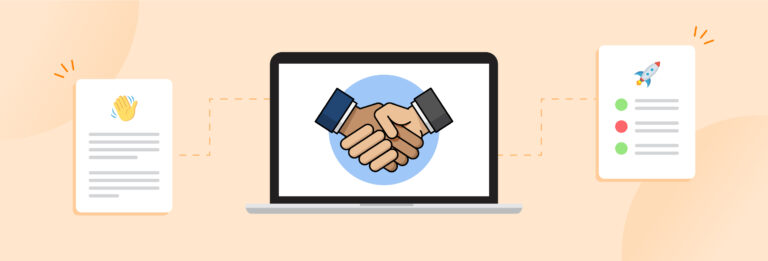Employee onboarding can either make or break employee experience. It is the first impression you make on your employees as an organization. An employee who feels welcomed and valued is the one who would contribute towards the success of the organization as well.
Poor employee onboarding, on the other hand, can lead to early exit and a bad experience on the part of both the parties. Read on to know the importance of a new employee onboarding process flow and how you can effectively set up a process in your organization.
What is onboarding process of new employees?

Employee onboarding is the time period from the day the offer letter is released to the time when an employee is trained enough to be considered as a full-time asset, basically covering the entire probation period. According to Gallup, 70% of employees who had exceptional onboarding are 2.6 times likely to be extremely satisfied with their workplace
The new employee onboarding process flow is almost similar for all organizations. However, the industry, the tasks involved, and the time taken is what makes it different from one company to the other. The process usually covers orientation, training plan, feedback loops, all of which help the employee in knowing the organization, its structure, the procedures, the people, and more in an effective manner.
Employee onboarding process is a step-by-step procedure of introducing the employees to the organization. It is the first interaction an employee has after joining the organization. Whatever the tenure, an employee onboarding process aims to make joining a breezy process for the employee and make them feel welcomed.
What are the components of a successful employee onboarding process?
Onboarding is a lengthy process that aims to help employees achieve justifiable output and successfully blend into the company culture. While each organization’s goals and processes are unique, the following elements and tools serve as a basis for a practical and robust new employee onboarding process flow.
Initial orientation
The initial orientation sets the tone for new recruits. Throughout the first three months, it gives them regular updates on initial plans, intent, and progress. The “shaping” of a person’s vision and corporate culture is frequently aided by this method.
The following are some examples of some potential tools:
- Corporate data, sales and business plans, and goals and objectives are delivered through e-learning modules, self-study, and instructor-led training with the assistance of the manager.
- Compliance training provided through e-learning modules, self-study, and ILT.
- Checklists to assist managers, HR reps, and new employees.
- Peer instructors and mentors.
- Contract for communication over the first three months.
Functional training
Functional training gives an overview of the company’s product and services and clients/customers. It also throws light on the company’s structure and system orientation related to its general systems (e.g., mail and Intranet) and role-specific systems requirements (e.g., SAP, CRM).
The following are some examples of potential tools:
- Role-specific training (more formal development for sales, marketing, research, etc. when appropriate for large groups).
- On-the-job learning opportunities for one-on-one development through e-learning modules, self-study, and ILT coaching in the presence of a manager.
Sessions on role clarification (first 30-90 days)
During these sessions, the new associate and appointed manager must have a quick chat to explain the expectations, deliverables, communication and decision-making preferences, and priorities. These sessions are critical for attaining important objectives.
Team integration
Facilitated team session(s), often without the new hire at first, elicit expectations, concerns, work style preferences, and perceived hurdles. The sessions include providing information about the team and recommendations for navigating the company successfully.
Leadership evaluation (after 60-90 days)
The leadership evaluation includes a review of the competencies required to succeed in the designated role and an assessment of whether the new employee is credible enough for the position. The new hire develops an understanding of the culture and identifies any necessary adjustments in behavior. Potential tools include examples for evaluating competencies and constructing a development plan.
What are the steps to creating a successful employee onboarding process?

Employee onboarding process flow is aimed at helping avoid any confusion and smoothening out issues that the new hire may have. If you are confused about how to improve onboarding process, here’s a new employee onboarding checklist to help you overcome the challenges.
Recruitment of an employee
The first step of employee onboarding is essentially a set of practices that you undertake before the actual hiring and onboarding process. This includes every activity — right from sending out the job description on various portals to the time the candidate is hired to be an employee.
The goal of the recruitment process is to find an employee who sits well with your company culture and its core values. Ensuring that you create an accurate job description before uploading it on the respective platforms, thoroughly assess prospective candidates and their understanding of the company’s mission and vision, and being completely transparent with the candidate in terms of what the job entails, can help ensure recruitment is a successful exercise.
The key to a good recruitment process is proper and accurate communication. Whether written or verbal, it should be in sync with the company policies and should not imply anything false.
Sending in the offer letter
A recruitment process is considered complete when the HR sends the offer letter to the candidate and the latter accepts it. The main goal here is to express the delight that an organization feels when choosing and bringing the said candidate on board and how there’s hope that they would be a valuable addition to the team.
At this stage, highlight the job responsibilities all over again to the candidate. Also, try to make the offer letter as detailed as possible, charting out all the benefits and policies. There should be no surprises for the employee or the employer later on.
Last but not the least, your offer letter should convey the right amount of excitement and going overboard with it might make an organization sound immature.
Organizing the first office visit
Once the candidate is hired is when the actual employee onboarding process begins and a major step after this is the first office visit. The main goal of this first visit is not to understand work, rather, it is to give the employee a glimpse into the working of the office and the company and team culture.
When taking a new hire on this visit, start with basic introductions and give the employee an intro of everyone you pass by, show them their desk and workspace, include a tour of the pantry and recreational areas, and share with them the itinerary and expectations for the first week.
Apart from the last activity, the first three can be assigned to an employee buddy as well. The objective is to make the first day of the employee as welcoming as possible, with it just being an easy introduction to the workplace, work people, and work practices.
Initiating the early onboarding process
The 2-3 weeks post signing the offer letter are quite crucial. If your candidate is not serving a notice period elsewhere, or is willing to start with minor procedures before joining the company as a functional employee, you can start an early onboarding.
These few weeks before the employee officially joins is a great opportunity to initiate employee engagement. The best way to do it would be by encouraging the hiring managers to be in touch with the employees and slowly easing them into work procedures.
Early onboarding also includes sending out welcome emails and involving the new hire in meetings and discussions to let them have an idea of their work. An AI-powered HR onboarding software can help you automate the entire new hire onboarding process and offer a stellar onboarding experience.
Welcoming the new hire
Note that the employee’s first visit to the office may not exactly be the first day at work. It may just be the first day when they are introduced to the organization’s culture and vibe. The official working day may be a different one. Hence, organizing an official welcome for the new hire on the day they join is extremely important, especially if you are in a remote working set-up which brings its own set of employee experience challenges when it comes to disconnect between employees.
The best way to start the day would be by scheduling a half an hour meeting before the work starts for a quick welcome and introduction and another half an hour meeting at the end of the day that can serve as a debriefing session. Hold ice-breaking game sessions and lunches that are informal and exciting in nature. The first day need not be all about work, formalities, and handovers and rather help establish a deeper understanding of work and vibe with the new hire. It is a crucial part of the employee onboarding process.
You could also welcome the employee with a brand kit. This is a popular practice nowadays and even in an in-office setup, this is quite exciting and a little luring as it gives the employee a sense of belonging.
Orientation session for the new hire
This is an extremely important aspect of the new employee onboarding process flow. The goal of the orientation process goes beyond the usual welcoming.
A good orientation process seeks to acquaint the new employee with their job role and responsibilities in the easiest and most comforting manner possible. The best way to do this would be to first send out a welcome email, and then conduct ‘meet and greet’ for specific departments and teams with whom the employee would be required to work. It is also a good practice to establish goals in the first few weeks so that the employee does not feel too lost or bombarded due to ample people and procedures.
Employee engagement and team building activities
As important as it is for the employee to acquaint themselves with their respective role in the company, it is also essential for them to know the people of the company better. This specifically holds true for their teams.
Try and conduct offline and online games and activities depending on whether or not yours is a remote work set-up. Indulge in employee recognition and employee engagement activities in order to ensure overall well being of new hires.
They serve as an encouraging platform, especially for new employees. Another new activity is arranging for blind coffee meet-ups in the office. However, this one needs to be done after carefully studying the persona of the new hire. An introvert would not appreciate it.
While these are more or less the common steps of employee onboarding across industries, few things may vary. Nevertheless, preparing the existing employees for the new hire, welcoming the employee and introducing them to all the teams, planning a team launch, etc. are some common activities that are done in every organization.
All said and done, an employee onboarding procedure and its entailing steps depend a lot on how well you assess the employee and make their first day, week, and month a welcome and warm one.
What are the benefits of employee onboarding?

While we have elucidated the process of onboarding already, it remains to be understood why this process is so crucial to an organization.
To understand why it is important to invest in the first few weeks of a new employee, it is imperative to know the benefits. Read on as we list the benefits of employee onboarding for you.
Helps establish trust
Your employee onboarding process is technically the employee’s first impression of the company’s procedures and policies. The smoother it is and the more welcome an employee feels, the trust factor would be higher. This would help them adjust better in the beginning and create an approachable image in their mind wherein they know they can reach out to you for anything.
Increases employee satisfaction
A good employee onboarding also increases employee satisfaction because it makes them feel welcome in a new space. Not every person is extroverted and outgoing enough to break the ice in a new space. When the company takes the initiative to pave that path for the new hire, it makes every employee feel welcome regardless of their personality, in turn leading to employee satisfaction.
Enhances employee productivity
An employee who feels satisfied with the company procedures and feels welcomed is more likely to be motivated and productive. This means they will take the initiative to introduce ideas and even adjust with the existing ones. Hence, a good onboarding process creates more productive employees.
Creates a better brand image
Nowadays, it is not just the organization that evaluates the candidates, but also vice versa. With the advent of professional platforms such as Glassdoor and LinkedIn, maintaining a good brand image in the hiring market has become more important than ever. A good employee onboarding process creates a good image in the job market, making it easier to attract the right candidates.
Enhances employee experience
A good employee onboarding process enhances the overall experience of the new hire. It makes them feel welcome personally and contributes towards their productivity professionally. Creating a good employee onboarding process is important as it’s your new hire’s first brush with the organization and shapes how an employee feels about being attached with the role.
Employee onboarding is an extensive process and it could last anywhere between a few weeks to 12 months. We understand entirely that automating certain repetitive parts of it could make your HR department’s life a lot easier.







6 Comments